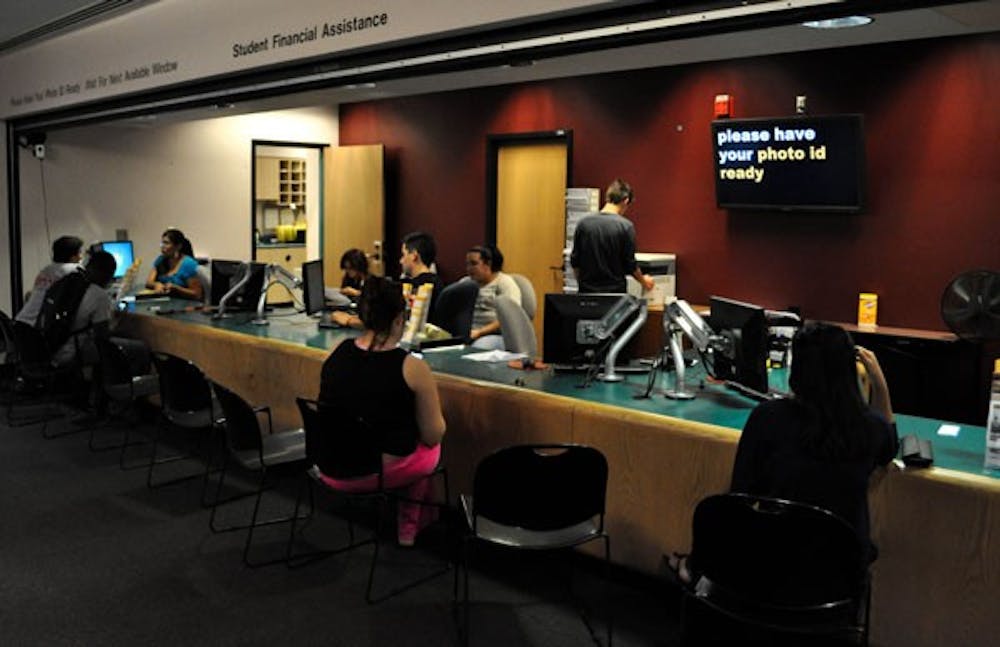 ASU students visit the Financial Aid Office at the Tempe campus Monday evening. According to a recent report from the Institute for College Access and Success, students who graduate from an Arizona college have the fifth lowest amount of debt in the country. (Photo by Danielle Gregory)
ASU students visit the Financial Aid Office at the Tempe campus Monday evening. According to a recent report from the Institute for College Access and Success, students who graduate from an Arizona college have the fifth lowest amount of debt in the country. (Photo by Danielle Gregory)Graduates from Arizona colleges in 2011 have some of the lowest student debt in the U.S., according to an October report from the Institute for College Access and Success.
Fewer than half of students who obtained bachelor’s degrees from Arizona colleges in 2011 graduated with debt, and those who did had an average debt of $19,950, according to the report.
Meanwhile, two-thirds of 2011 graduates nationwide have student debt loans, and the national average was $26,600, up 5.3 percent from 2010, according to the report.
The report said Arizona ranks 45th in average student debt.
Dennis Hoffman, director of the L. William Seidman Research Institute at the W. P. Carey School of Business, said this is because college students in Arizona pay a low tuition, especially compared to their counterparts in the Midwest and Northeast.
“I understand that some of your readers have debt and the fact that we are fifth lowest in the nation may not make them feel any better,” Hoffman said.
However, he said degrees from ASU in business, science and engineering yield high returns in the job market, citing Wall Street Journal and alumni studies.
The report said the national unemployment rate for college graduates is 8.8 percent, while total student debt nationwide has snowballed to more than $1 trillion.
The U.S. Department of Education reported more than one in 10 borrowers could not repay their education loans in the first three years.
Hoffman said in today’s tough labor market, students should pursue a major that excites them but remain aware of what employment opportunities are available in their field of study.
“If you are going to be taking on debt to acquire a college degree, you want to be especially vigilant to pursue a degree that yields a high rate of return,” he said. “The name of the game today is hit the ground running from day one.”
Student Economics Association Treasurer Chad Stearns said there is a need to explore the connection between education and income.
“Education is overrated and over-allocated,” he said. “There are a lot of people going to school who don’t need to and I would like to see some effort to tell people not to go to school.”
Stearns, a math and economics senior, said tuition should go up to discourage unqualified people from attending school.
Arizona Board of Regents spokeswoman Sarah Harper said in an email that fees at Arizona’s public universities remain competitive among similar institutions despite increases in recent years.
“While Arizona ranks near the bottom (nationally) with respect to state funded aid … ASU provides significant institutional financial aid,” she said.
ASU Student Financial Assistance Director Melissa Pizzo said in an email at least 70 percent of all ASU students receive some type of financial assistance.
She said in the 2010-11 academic year, about 49,000 undergraduate students were awarded more than $663 million in financial aid, including more than $328 million in scholarships and grant funding.
Giovanni Yakoo, president of business fraternity Phi Beta Lambda, said he is proud of Arizona and ASU for making higher education affordable.
“Congrats to us,” he said. “$20,000 is actually quite minimal considering some people rack up $80,000 or $100,000 as an undergrad.”
Yakoo, an economics and finance senior, said ASU offers top-notch undergraduate studies and is competitive on a national basis in most areas of study.
“To be on that level and not have to carry so much student debt makes ASU a great choice for all students seeking an education,” he said.
Reach the reporter at npmendo@asu.edu




